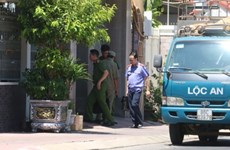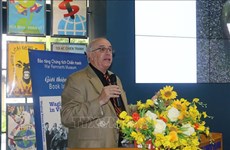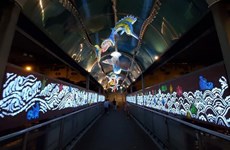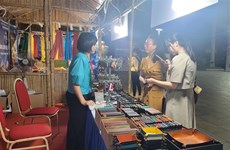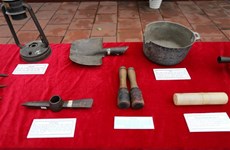The epic saga of Dien Bien Phu soldiers' lives
On March 13, 1954, 60 years ago, Vietnamese soldiers began a campaign
against the French heavily entrenched at Dien Bien Phu. After weeks of
arduous battles, the Vietnamese soldiers planted their victory flag on
the roof of the enemy command bunker, ending the campaign on May 7.
On March 13, 1954, 60 years ago, Vietnamese soldiers began a campaign
against the French heavily entrenched at Dien Bien Phu. After weeks of
arduous battles, the Vietnamese soldiers planted their victory flag on
the roof of the enemy command bunker, ending the campaign on May 7.
Veteran, 85-year-old Hoang Van Bay, living in Dien Bien city, was born in Dien Chau district in the central province of Nghe An and joined the army in 1952. Before joining the army, he had promised his villagers that he will try to complete his military tasks.
Early in 1954, during the Dien Bien Phu campaign, Bay and his comrades dug trenches to gradually approach positions of the French army.
Bay and his comrades fearlessly and excitedly rushed to fight the enemies.
During the campaign's 3rd stage that began on May 1, 1954, when the Vietnamese army attacked the eastern hills, his trench collapsed because of the enemy's artillery shelling. Bay was injured and he was transferred to the Muong Phang forest for treatment.
After he recovered from his injuries, Bay urged the officers to allow him to return to the front line to continue fighting. During the last battle, at 5am on May 7th, when the Vietnamese troops were advancing, he was hit by an artillery shell fragment on his thigh and was brought back to the hospital.
"I was lying in the hospital when I heard the news of our victory. All the doctors, nurses, and wounded soldiers screamed with delight," he recalled.
Patriotic seamstress
Female artist Nguyen Ngoc Diep, born in 1936, who served at the 308th Brigade, said that the years of the Dien Bien Phu campaign will be etched in her mind for life.
"During those fierce months, there was one special memory when I embroidered our military flag with the words ‘Quyet chien Quyet thang' (Determined to Fight and Win)," she said.
"Then, President Ho decided that he would grandly adorn his banners for the military units that achieved excellent feats during the war. However, no flags were available at the battlefield, so the Brigade commander assigned this task to the art troupe." The troupe then assigned the task to Diep and her comrade Phung De.
But she only had a piece of red cloth, and she wondered how she could make it into an embroidered flag?
Also, a yellow thread was needed to embroider the star and four letters "Quyet chien Quyet thang". Suddenly, Diep was struck with an idea. She used quinine drugs (to treat malaria) to dye the cloth.
These tablets were rapidly mobilized from the members of the troupe, and the soldiers then crushed and mixed them in water, which made it yellow in colour.
She used bandage to make another piece of cloth, dying it to yellow and then cutting the star and letters out of it.
"As we were marching continuously after dying the cloth, I had to hang it on my backpack to let it dry. I did it about three times," she said.
Until now, Diep still cannot understand how she could take that creative initiative during that time.
"Comrade De was very nifty with his hands. He cut out the star and the letters from a newspaper, and I then followed that shape to cut the fabric and then sew the flag. We also made the flag's tassels with white because at that time we did not have yellow tassels," Diep said.
While sewing the flag, Diep succumbed to fever as malaria had spread among several soldiers during the campaign.
Later, De recalled how he was moved to see a sickly Diep painstakingly stitching the flag, though he had to remain silent.
After she made the flag, Diep was taken to a makeshift hospital.
The interrogator
At the age of 20, after completing secondary school, Nguyen Xuan Tinh joined the army and volunteered to participate in the Dien Bien Phu campaign.
Even after 60 years, the memories of interrogating the French General Christian Castries are still fresh in his mind.
Tinh was a soldier at Brigade 312 and participated in the Dien Bien Phu campaign from the very beginning. After the Him Lam battle ended, as Tinh was fluent in French, he was assigned the task of interrogating the prisoners.
On May 7, 1954, at 17.30pm, the Vietnamese army overan the French headquarters and captured Gen de Castries and the entire staff of the French army.
Tinh was assigned the task of directly interrogating de Castries. He recollected that, firstly he asked for the prisoner's name, rank, and then questioned him:
You and the French Expeditionary Command in Indochina declared that Dien Bien Phu is an "impregnable fortress", and you sent your aircraft to drop leaflets inviting us to come. Now what do you think?
De Castries answered: Yes, today we met you.
How do you evaluate your artillery force at Dien Bien Phu as your artillery officer declared that "After counter-firing for just 10 minutes, the Vietnamese artillery would be silenced and be crushed in two days"?
We did not expect that you would bring your heavy artillery up to Dien Bien Phu and would use them effectively. You have thus suppressed our artillery.
Because your artillery could not crush us so your artillery officer has crushed himself with a grenade?
Yes! He bravely ended his own life.
You received a telegraph from General Navarre who told you to break the siege and run to Laos, why didn't you do it?
You have tightened the siege and arranged forces to ambush, so we could not take the risk.
You did not break out, it means that you must have been defeated and surrendered, when did you know about it?
When you detonated a large explosive block at Hill A1 and began to fire your Kachiusa missiles, we knew that we had lost.
After an envoy of the Vietnamese Command compared the photograph and signature of Gen de Castries, and confirmed that the captive was indeed the French commander in chief of the Dien Bien Phu Battle.-VNA
Veteran, 85-year-old Hoang Van Bay, living in Dien Bien city, was born in Dien Chau district in the central province of Nghe An and joined the army in 1952. Before joining the army, he had promised his villagers that he will try to complete his military tasks.
Early in 1954, during the Dien Bien Phu campaign, Bay and his comrades dug trenches to gradually approach positions of the French army.
Bay and his comrades fearlessly and excitedly rushed to fight the enemies.
During the campaign's 3rd stage that began on May 1, 1954, when the Vietnamese army attacked the eastern hills, his trench collapsed because of the enemy's artillery shelling. Bay was injured and he was transferred to the Muong Phang forest for treatment.
After he recovered from his injuries, Bay urged the officers to allow him to return to the front line to continue fighting. During the last battle, at 5am on May 7th, when the Vietnamese troops were advancing, he was hit by an artillery shell fragment on his thigh and was brought back to the hospital.
"I was lying in the hospital when I heard the news of our victory. All the doctors, nurses, and wounded soldiers screamed with delight," he recalled.
Patriotic seamstress
Female artist Nguyen Ngoc Diep, born in 1936, who served at the 308th Brigade, said that the years of the Dien Bien Phu campaign will be etched in her mind for life.
"During those fierce months, there was one special memory when I embroidered our military flag with the words ‘Quyet chien Quyet thang' (Determined to Fight and Win)," she said.
"Then, President Ho decided that he would grandly adorn his banners for the military units that achieved excellent feats during the war. However, no flags were available at the battlefield, so the Brigade commander assigned this task to the art troupe." The troupe then assigned the task to Diep and her comrade Phung De.
But she only had a piece of red cloth, and she wondered how she could make it into an embroidered flag?
Also, a yellow thread was needed to embroider the star and four letters "Quyet chien Quyet thang". Suddenly, Diep was struck with an idea. She used quinine drugs (to treat malaria) to dye the cloth.
These tablets were rapidly mobilized from the members of the troupe, and the soldiers then crushed and mixed them in water, which made it yellow in colour.
She used bandage to make another piece of cloth, dying it to yellow and then cutting the star and letters out of it.
"As we were marching continuously after dying the cloth, I had to hang it on my backpack to let it dry. I did it about three times," she said.
Until now, Diep still cannot understand how she could take that creative initiative during that time.
"Comrade De was very nifty with his hands. He cut out the star and the letters from a newspaper, and I then followed that shape to cut the fabric and then sew the flag. We also made the flag's tassels with white because at that time we did not have yellow tassels," Diep said.
While sewing the flag, Diep succumbed to fever as malaria had spread among several soldiers during the campaign.
Later, De recalled how he was moved to see a sickly Diep painstakingly stitching the flag, though he had to remain silent.
After she made the flag, Diep was taken to a makeshift hospital.
The interrogator
At the age of 20, after completing secondary school, Nguyen Xuan Tinh joined the army and volunteered to participate in the Dien Bien Phu campaign.
Even after 60 years, the memories of interrogating the French General Christian Castries are still fresh in his mind.
Tinh was a soldier at Brigade 312 and participated in the Dien Bien Phu campaign from the very beginning. After the Him Lam battle ended, as Tinh was fluent in French, he was assigned the task of interrogating the prisoners.
On May 7, 1954, at 17.30pm, the Vietnamese army overan the French headquarters and captured Gen de Castries and the entire staff of the French army.
Tinh was assigned the task of directly interrogating de Castries. He recollected that, firstly he asked for the prisoner's name, rank, and then questioned him:
You and the French Expeditionary Command in Indochina declared that Dien Bien Phu is an "impregnable fortress", and you sent your aircraft to drop leaflets inviting us to come. Now what do you think?
De Castries answered: Yes, today we met you.
How do you evaluate your artillery force at Dien Bien Phu as your artillery officer declared that "After counter-firing for just 10 minutes, the Vietnamese artillery would be silenced and be crushed in two days"?
We did not expect that you would bring your heavy artillery up to Dien Bien Phu and would use them effectively. You have thus suppressed our artillery.
Because your artillery could not crush us so your artillery officer has crushed himself with a grenade?
Yes! He bravely ended his own life.
You received a telegraph from General Navarre who told you to break the siege and run to Laos, why didn't you do it?
You have tightened the siege and arranged forces to ambush, so we could not take the risk.
You did not break out, it means that you must have been defeated and surrendered, when did you know about it?
When you detonated a large explosive block at Hill A1 and began to fire your Kachiusa missiles, we knew that we had lost.
After an envoy of the Vietnamese Command compared the photograph and signature of Gen de Castries, and confirmed that the captive was indeed the French commander in chief of the Dien Bien Phu Battle.-VNA









